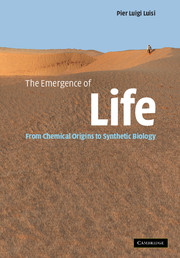Book contents
- Frontmatter
- Contents
- Preface
- Acknowledgments
- List of books on the origin of life
- 1 Conceptual framework of research on the origin of life on Earth
- 2 Approaches to the definitions of life
- 3 Selection in prebiotic chemistry: why this … and not that?
- 4 The bottle neck: macromolecular sequences
- 5 Self-organization
- 6 The notion of emergence
- 7 Self-replication and self-reproduction
- 8 Autopoiesis: the logic of cellular life
- 9 Compartments
- 10 Reactivity and transformation of vesicles
- 11 Approaches to the minimal cell
- Outlook
- References
- Index
Outlook
Published online by Cambridge University Press: 17 December 2010
- Frontmatter
- Contents
- Preface
- Acknowledgments
- List of books on the origin of life
- 1 Conceptual framework of research on the origin of life on Earth
- 2 Approaches to the definitions of life
- 3 Selection in prebiotic chemistry: why this … and not that?
- 4 The bottle neck: macromolecular sequences
- 5 Self-organization
- 6 The notion of emergence
- 7 Self-replication and self-reproduction
- 8 Autopoiesis: the logic of cellular life
- 9 Compartments
- 10 Reactivity and transformation of vesicles
- 11 Approaches to the minimal cell
- Outlook
- References
- Index
Summary
The field of the origin of life has progressed very much from the time of Stanley Miller's first experiment. However, the main hypothesis, that cellular life derives from inanimate matter, has not been demonstrated yet. It must then be considered still aworking hypothesis. Not thatwehave alternatives within the realms of science, and I have outlined in Chapter 1 why divine creation cannot be considered as an alternative within science. Of course the question of God is not one that is solved in terms of rationality, but in terms of faith, and we are back to zero.
I have stressed in this book that one of the main reasons why the bottom-up approach to the transition to life has not been corroborated experimentally lies, among others, in the fact that the sequence of our macromolecules of life – enzymes, RNA, and DNA – are the products of the vagaries of contingency and by definition it is then impossible to reproduce them in the laboratory.
I would like to add that there are so many claims about the origin of life – it has been “found” on hydrothermal vents, on ice, on clay, on pyrite, at very high and very low pressure … and there are so many corresponding “worlds” – but, as we have seen, all these worlds stop at the synthesis of low-molecular-weight compounds or at the most short oligomers.
Information
- Type
- Chapter
- Information
- The Emergence of LifeFrom Chemical Origins to Synthetic Biology, pp. 268 - 270Publisher: Cambridge University PressPrint publication year: 2006
